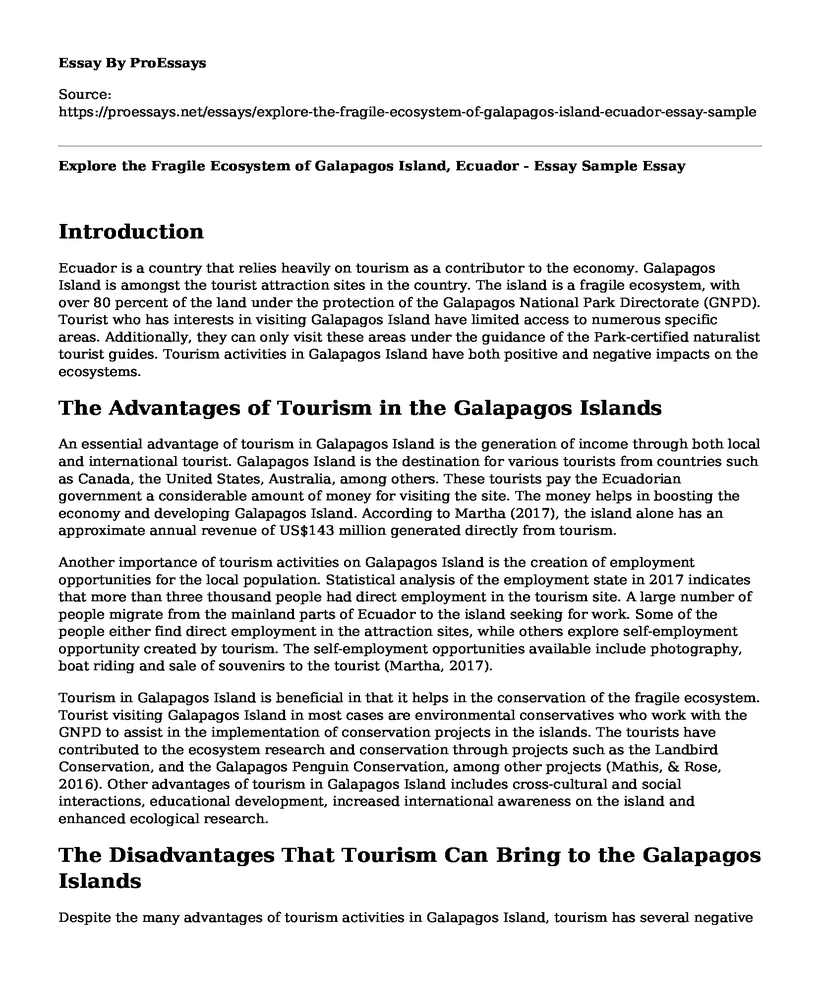Introduction
Ecuador is a country that relies heavily on tourism as a contributor to the economy. Galapagos Island is amongst the tourist attraction sites in the country. The island is a fragile ecosystem, with over 80 percent of the land under the protection of the Galapagos National Park Directorate (GNPD). Tourist who has interests in visiting Galapagos Island have limited access to numerous specific areas. Additionally, they can only visit these areas under the guidance of the Park-certified naturalist tourist guides. Tourism activities in Galapagos Island have both positive and negative impacts on the ecosystems.
The Advantages of Tourism in the Galapagos Islands
An essential advantage of tourism in Galapagos Island is the generation of income through both local and international tourist. Galapagos Island is the destination for various tourists from countries such as Canada, the United States, Australia, among others. These tourists pay the Ecuadorian government a considerable amount of money for visiting the site. The money helps in boosting the economy and developing Galapagos Island. According to Martha (2017), the island alone has an approximate annual revenue of US$143 million generated directly from tourism.
Another importance of tourism activities on Galapagos Island is the creation of employment opportunities for the local population. Statistical analysis of the employment state in 2017 indicates that more than three thousand people had direct employment in the tourism site. A large number of people migrate from the mainland parts of Ecuador to the island seeking for work. Some of the people either find direct employment in the attraction sites, while others explore self-employment opportunity created by tourism. The self-employment opportunities available include photography, boat riding and sale of souvenirs to the tourist (Martha, 2017).
Tourism in Galapagos Island is beneficial in that it helps in the conservation of the fragile ecosystem. Tourist visiting Galapagos Island in most cases are environmental conservatives who work with the GNPD to assist in the implementation of conservation projects in the islands. The tourists have contributed to the ecosystem research and conservation through projects such as the Landbird Conservation, and the Galapagos Penguin Conservation, among other projects (Mathis, & Rose, 2016). Other advantages of tourism in Galapagos Island includes cross-cultural and social interactions, educational development, increased international awareness on the island and enhanced ecological research.
The Disadvantages That Tourism Can Bring to the Galapagos Islands
Despite the many advantages of tourism activities in Galapagos Island, tourism has several negative impacts on the island. First, tourism activities contribute to the massive migration of people from the mainland into the island. The movement of people generates excess stress on fragile ecosystems. The island is slowly becoming overwhelmed with the large population of tourists and the locals. The high population links directly to other problems such as increased waste disposal both on the island and the water. Additionally, the tourist who lives in their cruises dumps their wastes directly into the water. Therefore, tourism in the area leads to a disruption in the ecosystem (Mathis, & Rose, 2016).
Some of the tourist visiting Galapagos Island participate in illegal hunting and fishing. The hunting and fishing affect the ecosystem in that it reduces the number and species of animals and fish in the highland. Besides hunting, tourism activities in the area have been the direct cause of the reduction in the number of the tortoise and the blue-footed boobies as the tourist interfere with their natural habitat through littering and noise.
Tourism in the Galapagos Islands has led to the rapid development of the area. The natural habitats of the animals are rapidly developing into buildings, roads and car parks. The disruption of the natural soil also affects the ecosystem and the habitation of the animals. In general, the development of the area has led to the pollution of land and water. Therefore, water quality is low for the aquatic animals. Other significant problems of tourism in Galapagos Island include moral degradation among the locals, unhealthy business competitions in the hotels, and sanitation issues, among others.
References
Mathis, A., & Rose, J. (2016). Balancing tourism, conservation, and development: a political ecology of ecotourism on the Galapagos Islands. Journal of Ecotourism, 15(1), 64-77.
Martha, M. (2017). Tourism and the Galapagos Islands: Examining the Relationship Between Ecotourism and the Local Population. Hofstra University. Recuperado em, 22.
Cite this page
Explore the Fragile Ecosystem of Galapagos Island, Ecuador - Essay Sample. (2023, Apr 23). Retrieved from https://proessays.net/essays/explore-the-fragile-ecosystem-of-galapagos-island-ecuador-essay-sample
If you are the original author of this essay and no longer wish to have it published on the ProEssays website, please click below to request its removal:
- DMO Involvement in the Destinations Product Development - Paper Example on Tourism in Italy
- Halong Bay, Vietnam Essay
- Dark Tourism Essay
- Essay Sample on Competition in Tourism Industry in Singapore
- Essay Sample on The City of Martinville, Louisiana
- Essay Example on National Tourist Organization: Leveraging Tourism for Country's Development
- Essay Example on Ropeways in Tourism: An Overview







